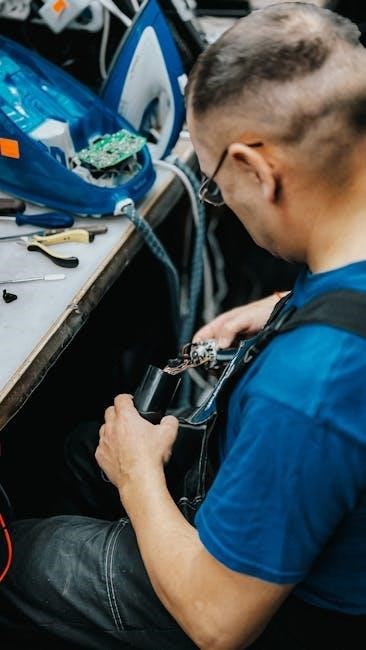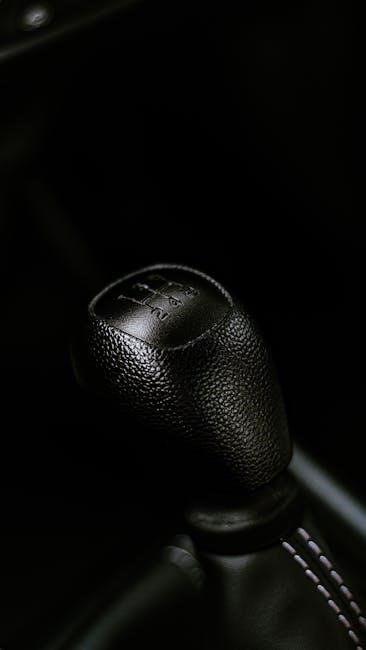Recognizing symptoms of a failing manual transmission is crucial for preventing further damage. Common issues include slipping gears, fluid leaks, and unusual noises, requiring prompt attention.
Overview of Manual Transmission Basics
A manual transmission, also known as a stick shift, is a gearbox that requires the driver to manually change gears using a clutch pedal and shift lever. It relies on a system of gears, bearings, and synchronizers to transmit power from the engine to the wheels. The clutch disengages the engine from the transmission, allowing smooth gear shifts. Synchronizers ensure gears mesh properly, preventing grinding. Manual transmissions are known for their fuel efficiency, driver control, and lower cost compared to automatics. However, they require more driver skill and attention. Understanding these basics helps in identifying when something goes wrong, as improper operation or wear can lead to common issues like slipping gears or difficulty shifting.
Importance of Identifying Symptoms Early
Early detection of manual transmission issues is vital to prevent minor problems from escalating into costly repairs. Symptoms like slipping gears or fluid leaks can quickly lead to internal damage if ignored. Addressing these signs promptly ensures the transmission remains functional and avoids breakdowns. Regular checks and maintenance can extend the lifespan of the transmission, saving time and money. Ignoring early warnings may result in needing a full transmission rebuild or replacement, which is both expensive and time-consuming. By staying vigilant and addressing issues early, drivers can maintain their vehicle’s performance and reliability on the road.

Common Symptoms of a Bad Manual Transmission

A failing manual transmission often exhibits gears slipping, fluid leaks, burning smells, shaking, grinding noises, and difficulty shifting. These signs indicate potential internal damage or wear.
Gears Slipping or Failing to Engage
Gears slipping or failing to engage is a common symptom of a bad manual transmission. This occurs when the transmission fails to maintain gear engagement, causing the car to lose acceleration or struggle to stay in gear. Drivers may notice the vehicle “slipping” out of gear unexpectedly, especially when accelerating or climbing inclines. This issue can stem from low transmission fluid levels, worn clutch components, or internal gear damage. If left unaddressed, it can lead to further damage, such as stripped gears or synchronizer failure. Checking transmission fluid levels and inspecting the clutch and gear components are essential first steps. If the problem persists, professional diagnosis is recommended to prevent costly repairs.
Transmission Fluid Leakage
Transmission fluid leakage is a common symptom of a bad manual transmission. It occurs when seals or gaskets within the transmission system wear out, allowing fluid to escape. Drivers may notice oil spots under the vehicle or a low transmission fluid level. This leakage can lead to reduced lubrication, causing gears to slip or fail to engage properly. Ignoring this issue can result in increased wear and tear on internal components, potentially leading to costly repairs. Regularly checking for signs of leaks and maintaining proper fluid levels is essential to prevent further damage. Addressing this issue early can help avoid more severe transmission problems down the road.
Burning Smell from the Transmission
A burning smell from the transmission is a concerning symptom that often indicates overheating or excessive friction within the system. This odor can result from clutch wear, improper engagement, or low transmission fluid levels, which reduce lubrication and cause components to overheat. If left unaddressed, this issue can lead to irreversible damage to gears, bearings, or other internal parts. Drivers should immediately check the transmission fluid level and top it off if necessary. Persistent burning smells may require professional inspection to identify underlying causes, such as worn clutch components or faulty gear engagement. Addressing this issue promptly can prevent costly repairs and ensure the transmission operates smoothly.
Shaking or Jerking Sensations
Shaking or jerking sensations while driving can indicate issues with the manual transmission or its connected components. These sensations often occur during acceleration or when shifting gears, signaling problems like worn clutch components, misaligned drivetrain parts, or faulty transmission mounts. A malfunctioning clutch may cause the vehicle to shudder, especially when engaging or disengaging gears. Similarly, loose or damaged transmission mounts can create vibrations, leading to a jerking feeling. Addressing these issues promptly is essential to prevent further damage. Drivers should inspect the clutch and mounts for wear or misalignment; If the problem persists, consulting a professional mechanic is advisable to diagnose and repair underlying causes before they escalate into more severe transmission failure.
Grinding or Clunking Noises
Grinding or clunking noises during gear shifts are clear indicators of a manual transmission issue. These sounds often occur when worn or damaged components, such as gears or bearings, are no longer functioning smoothly. If the noise happens when shifting into specific gears, it may signal gear teeth wear or misalignment. Similarly, a clunking sound during acceleration or deceleration could point to a faulty clutch or damaged drivetrain components. Ignoring these noises can lead to further damage, potentially requiring costly repairs. It’s essential to inspect the transmission and related parts promptly. A professional mechanic should be consulted to identify the root cause and perform necessary repairs to restore smooth operation.
Difficulty Shifting Gears
Difficulty shifting gears is a common symptom of a failing manual transmission. This issue can arise due to low or dirty transmission fluid, which hinders gear engagement. Worn clutch components or a faulty shift linkage may also cause gears to feel stiff or unresponsive. If gears are hard to shift or stick in place, it can lead to further damage if ignored. Regularly checking and maintaining transmission fluid levels is essential to prevent such problems. Additionally, inspecting the clutch and shift linkage for wear can help address the issue early. Consulting a professional mechanic is recommended to diagnose and repair the underlying cause, ensuring smooth gear transitions and preventing more severe transmission damage.

Causes of Manual Transmission Problems
Manual transmission issues often stem from low or dirty fluid, worn clutch components, faulty shift linkages, or internal gear damage, all requiring timely attention to prevent escalation.
Low or Dirty Transmission Fluid
Low or dirty transmission fluid is a common cause of manual transmission problems. Transmission fluid lubricates gears and ensures smooth operation. When levels drop or fluid becomes contaminated, gears may slip or fail to engage properly. Dirty fluid can also lead to increased wear on internal components, accelerating damage. Regular fluid checks are essential to maintain optimal levels and cleanliness. If fluid levels are low, refilling with the correct type is crucial. Dirty fluid should be replaced promptly to prevent further issues. Neglecting this can result in costly repairs, such as replacing damaged gears or seals. Always consult a mechanic if symptoms persist after addressing fluid-related issues.
Worn or Damaged Clutch
A worn or damaged clutch is a common issue in manual transmissions, often leading to difficulty engaging gears. The clutch connects and disconnects the engine from the transmission, and when it wears out, it can cause gears to slip or fail to shift properly. Symptoms include a spongy clutch pedal, grinding noises, or the inability to accelerate smoothly. If the clutch is damaged, it may need to be replaced to restore proper transmission function. Ignoring this issue can lead to further damage, such as worn gears or synchronizers. Regular inspection and timely replacement of worn clutch components are essential to maintain smooth and efficient gear shifting. Always consult a mechanic for professional diagnosis and repair.

Faulty Shift Lever or Linkage
A faulty shift lever or linkage can mimic transmission problems, even though it’s not part of the transmission itself. Over time, wear and tear can cause the shifter to become loose or misaligned, leading to gears slipping or failing to engage properly. Symptoms include difficulty shifting, grinding noises, or the gear shifter feeling unstable. If the linkage is damaged, it may prevent the transmission from receiving proper signals, resulting in poor gear engagement. Regular inspection of the shift linkage and lubrication can help prevent issues. However, if problems persist, it’s essential to have the linkage repaired or replaced by a professional mechanic to ensure smooth and precise gear shifting. Addressing this issue early can prevent further damage to the transmission system.
Internal Gear Damage
Internal gear damage is a severe issue that can arise from prolonged neglect of transmission maintenance. Symptoms include unusual grinding or clunking noises during gear shifts, difficulty engaging gears, and vibrations while driving. This damage often results from worn-out synchronizers, excessive wear on gear teeth, or foreign debris inside the transmission. If left unaddressed, internal gear damage can lead to complete transmission failure, requiring costly repairs or even a full replacement. Early diagnosis is critical to prevent further deterioration. Regular maintenance, such as checking transmission fluid levels and avoiding aggressive driving habits, can help prevent internal gear damage. Addressing symptoms promptly ensures the longevity of your manual transmission system.

Diagnosis and Repair of Manual Transmission Issues
Early detection of transmission problems is key to preventing costly repairs. Professional diagnosis ensures accurate identification of issues, while prompt action avoids further damage and extends lifespan.
Steps to Diagnose Transmission Problems
Diagnosing manual transmission issues requires a systematic approach. Start by checking the transmission fluid level and condition, as low or dirty fluid can cause symptoms. Listen for unusual noises, such as grinding or clunking sounds, while shifting gears. Feel for vibrations or jerking sensations during acceleration or deceleration. Inspect for leaks around the transmission pan or seals, as fluid leakage is a common issue. Test the clutch pedal to ensure it engages and disengages properly. If symptoms persist, a professional mechanic may need to perform a more detailed inspection, including internal components like gears and bearings. Early detection can prevent minor issues from becoming major repairs.
When to Visit a Professional Mechanic
If you notice persistent symptoms like gears slipping, grinding noises, or fluid leaks, it’s essential to visit a professional mechanic. DIY checks can help identify issues, but complex problems require specialized tools and expertise. For instance, if shifting becomes difficult or a burning smell persists, internal damage may be occurring. A mechanic can inspect the clutch, gears, and transmission components to pinpoint the root cause. Delaying professional help can lead to costly repairs or even transmission failure. Don’t hesitate to seek expert assistance if symptoms worsen or you’re unsure about the issue. Early intervention ensures your vehicle runs smoothly and prevents further damage.
Cost-Effective Repair Options
Addressing manual transmission issues early can save money. Replacing transmission fluid or fixing minor leaks are cost-effective solutions. If the clutch is worn, replacing it promptly prevents further damage. Refurbishing damaged gears or bearings is often cheaper than buying new parts. For severe problems, consider used or rebuilt transmission components. DIY repairs for minor issues, like adjusting the shift linkage, can also reduce costs. However, complex internal damage may require professional intervention. Prioritizing regular maintenance, such as fluid checks, can prevent costly repairs. Balancing timely fixes with budget-friendly options ensures your manual transmission runs smoothly without breaking the bank.

Maintenance Tips to Prevent Transmission Failure

Regular fluid checks and replacing worn clutch components are essential. Avoid aggressive driving habits to reduce wear on gears and internal mechanisms, ensuring longevity and smooth operation.
Regular Transmission Fluid Checks
Regular transmission fluid checks are vital for maintaining manual transmission health. Low or dirty fluid can lead to gears slipping or failing to engage, causing costly damage. Inspect the fluid level and condition monthly, ensuring it’s clean and at the recommended level. If the fluid appears dark or has a burnt smell, it’s time for a change. Always use the manufacturer-recommended fluid type to prevent compatibility issues. Neglecting fluid maintenance can result in premature wear on internal components, leading to more severe problems like grinding noises or difficulty shifting gears. Stay proactive to avoid these issues and extend your transmission’s lifespan.
Replacing Worn Clutch Components
Replacing worn clutch components is essential for maintaining smooth manual transmission operation. A worn clutch can cause slippage, difficulty shifting gears, and even complete disengagement. Symptoms include a spongy clutch pedal or a grinding noise when shifting. If ignored, worn components can lead to costly damage, such as flywheel wear or transmission harm. Regular inspection of the clutch disc, pressure plate, and release bearing is recommended. Replace any worn or damaged parts promptly to ensure proper engagement and prevent further issues. Addressing clutch wear early can save time and money, keeping your manual transmission functioning efficiently and reliably. Consult a mechanic for professional installation to guarantee optimal performance.
Avoiding Aggressive Driving Habits
Avoiding aggressive driving habits is key to preserving the health of your manual transmission. Rapid acceleration, hard shifting, and riding the clutch can strain transmission components, leading to premature wear. These practices can cause gears to slip, synchros to wear out, and the clutch to degrade faster. To prevent damage, adopt smoother driving techniques, such as gradual acceleration and shifting gears smoothly. Avoid keeping the clutch partially engaged, as this can overheat and wear down the clutch disc. By driving gently and mindfully, you can extend the life of your transmission and reduce the likelihood of costly repairs. Consistent gentle driving habits will help maintain optimal performance and minimize wear on critical components.

Recognizing and addressing manual transmission symptoms early is vital for maintaining performance and preventing costly repairs. Regular maintenance and mindful driving habits ensure longevity and optimal function.
Key symptoms of a bad manual transmission include gears slipping, fluid leaks, burning smells, and unusual noises. Early identification is crucial to prevent further damage. Solutions involve checking transmission fluid levels, replacing worn components like the clutch, and addressing linkage issues; Regular maintenance, such as fluid changes and inspecting seals, can prevent many problems. If symptoms persist, professional diagnosis is recommended to avoid costly repairs. Addressing issues promptly ensures smooth performance and extends the transmission’s lifespan. By staying vigilant and proactive, drivers can maintain their vehicle’s health and avoid severe transmission failure.
Final Thoughts on Transmission Care

Proper care and attention to your manual transmission are essential for its longevity. Regular checks of transmission fluid, avoiding aggressive driving, and addressing symptoms early can prevent major issues. Replacing worn components like the clutch and ensuring the shift linkage is in good condition are key maintenance steps. If problems arise, seeking professional help promptly can save time and money. By staying proactive and informed, drivers can enjoy a smooth, reliable driving experience. Remember, a well-maintained transmission not only enhances performance but also reduces the risk of unexpected breakdowns, ensuring your vehicle runs efficiently for years to come.